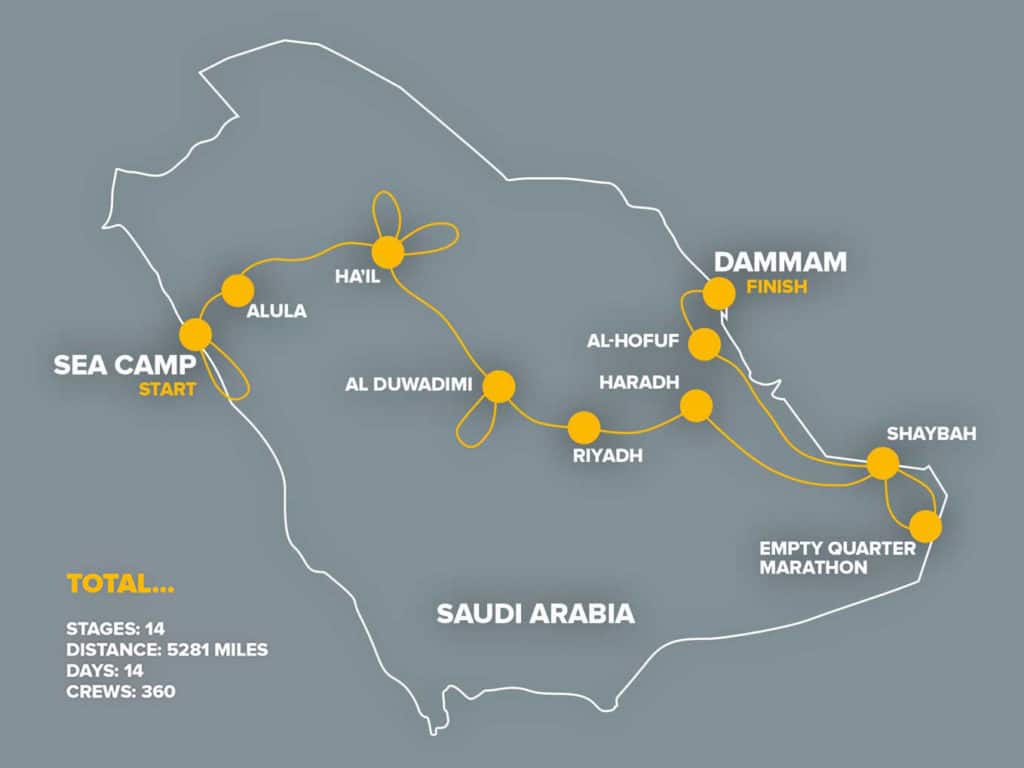Navigating in the middle of nowhere: Dakar's brutal challenge
Despite its inhospitable conditions the Dakar Rally continues to attract motor sport royalty and major manufacturers. Dominic Tobin is in the desert to find out which drivers mastered the dunes
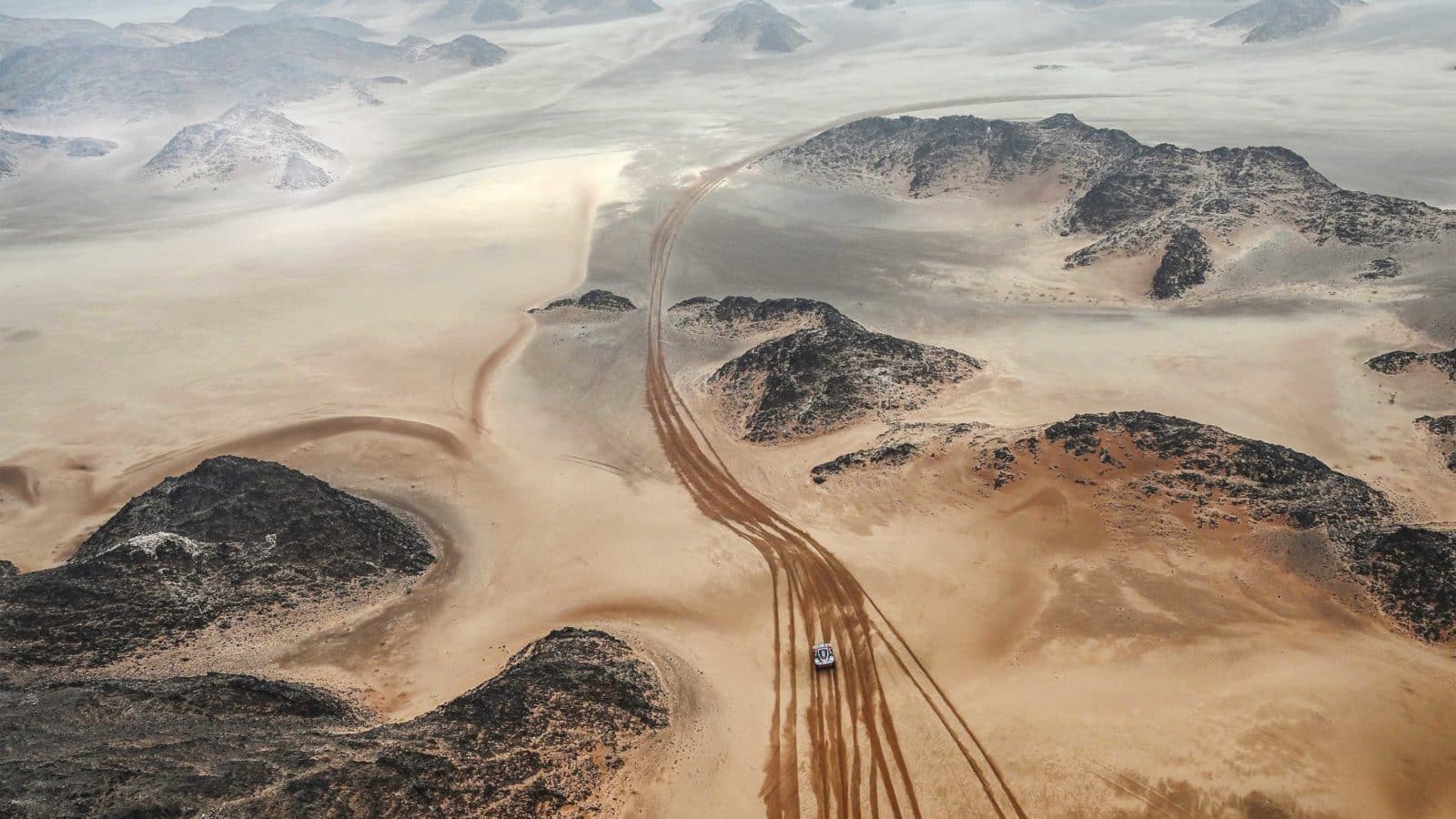
ASO/Fotop
The only sound is the wind rustling through the camel grass, sand stretching as far as the eye can see. We’re somewhere in Saudi Arabia’s 1.18 million square miles of desert in what appears to be total isolation until the faint hum of a four-stroke engine carries across the landscape.
When the Dakar arrives, you hear it first. Squinting into the distance, you spy a silhouette speeding across the horizon. The sound muffles as it disappears into a dip, then the rasp suddenly echoes around the valley as the bike and rider burst back into view, approaching at speed.
They scud along a crest, disappear behind a mound and then scramble up the hillside, metres from our waiting group that’s showered by the plume of sand kicked up in the wake.
The path taken by the lead bike is carved through the valley below, a dark line arcing across the desert with gaps where the machine leapt over the rugged terrain.
Then come the others: more following the same path, riders constantly hauling their bikes into line as they slide and skid on the soft surface. They’re followed by quad bikes and then the cars in fast pursuit: the barking twin-turbo Toyota V6s and the otherworldly Audis, with squealing electric motors that drive the wheels and a droning engine turning at constant revs to power its batteries.
Later will come the buggies, windows open to the elements, and the monstrous trucks that look like they are more likely to crush rather than crest the dunes as part of the metal migration of 441 vehicles that looks dramatic from the sidelines, but offers motor racing’s toughest test for those participants.
“A good navigator with a medium driver can still have a good result”
“Here, you cannot cheat yourself,” says Jacky Ickx, a 14-time entrant who won in 1983. “You cannot tell yourself all sorts of stories when you make a mistake. The surroundings show how small you are on the planet when you are in the middle of nowhere.”
Mention the Dakar to a non motor sport fan and you’ll typically see a distant look appear in their eyes before they ask quizzically, “Mark Thatcher?”
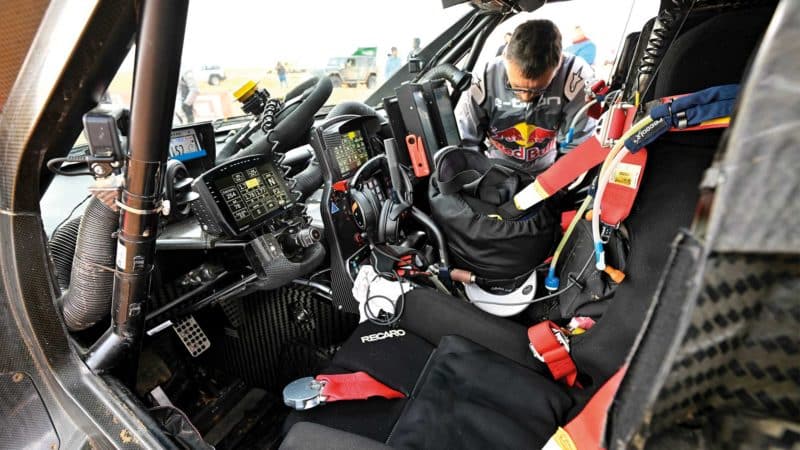
Behind every great Dakar driver there’s a phenomenal navigator – like Lucas Cruz.
Audi AG
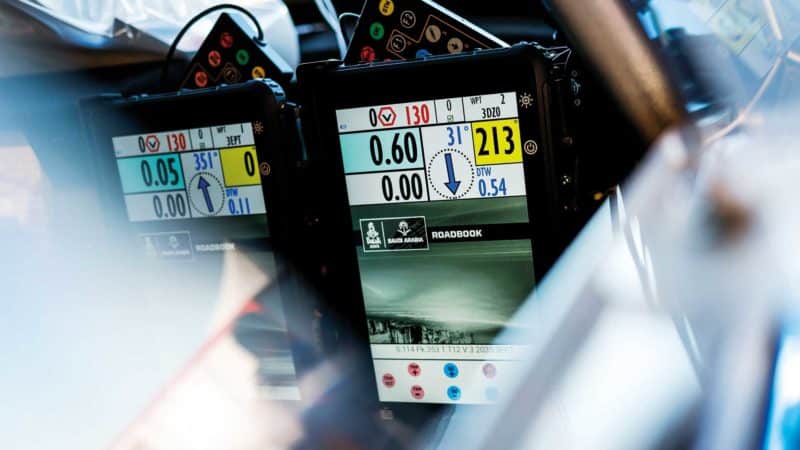
Are we there yet?
ASO/C Lopez/J Delfosse/DPPI

Sébastien Loeb in a spot of bother on stage five
ASO/C Lopez/J Delfosse/DPPI
Despite the racing greats that have torn through the desert during the rally’s history, it is apt that the son of a former prime minister getting lost in 1982 remains the race’s best-known story. Off the radar in Algeria for six days, Thatcher’s disappearance shows the peril of the rally where it’s all too easy to take a wrong turn in mile after mile of endless sand.
The advent of GPS and emergency beacons mean that there’s now slim chance of disappearing for days, but it’s all too easy to lose hours — and any chance of the race win with a wrong turn. Which is why, unless you’re flying solo on a quad bike or motorbike, you’ll need a world-class navigator to have any hope of winning the Dakar.
“It’s nothing like WRC where most of the result is done by the driver,” says Toyota co-driver Mathieu Baumel, who forms one of Dakar’s most successful pairings with Nasser Al-Attiyah. “Last year at the Monte Carlo Rally Sébastien Loeb changed his co-driver and still won. If you do that on the Dakar, no way. A good navigator with a medium [ability] driver can still have a good result.”
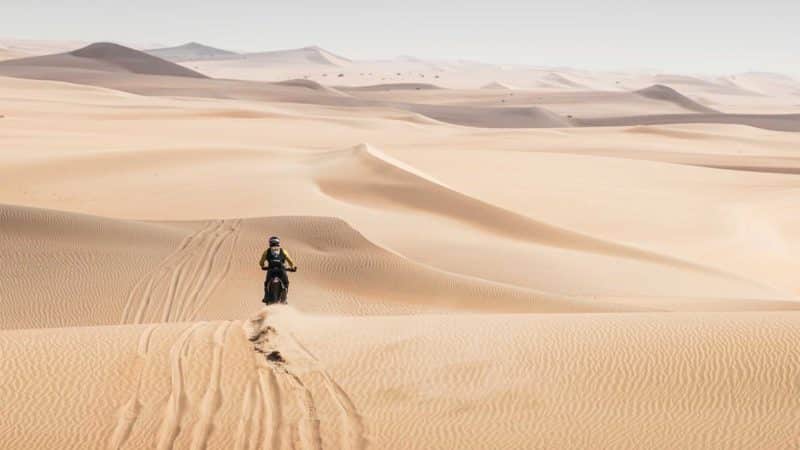
Stefan Svitko of Slovakia somewhere between Haradh and Shaybah – ‘the realm of the dunes’.
ASO/C Lopez/J Delfosse/DPPI
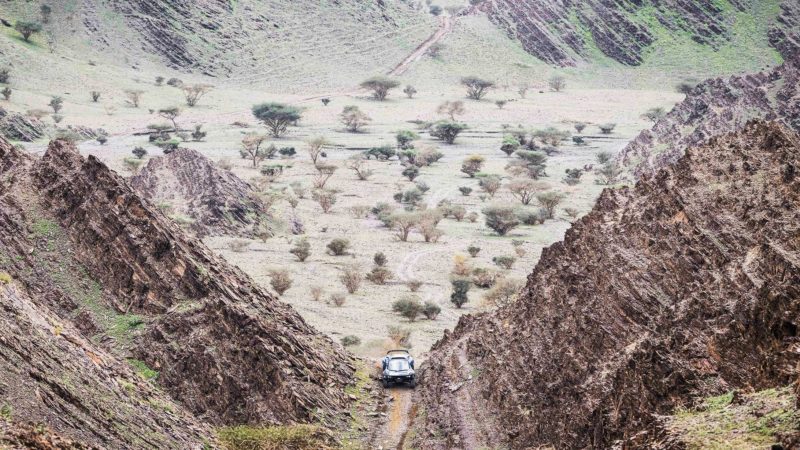
Heading inland on stage two.
ASO/C Lopez/J Delfosse/DPPI
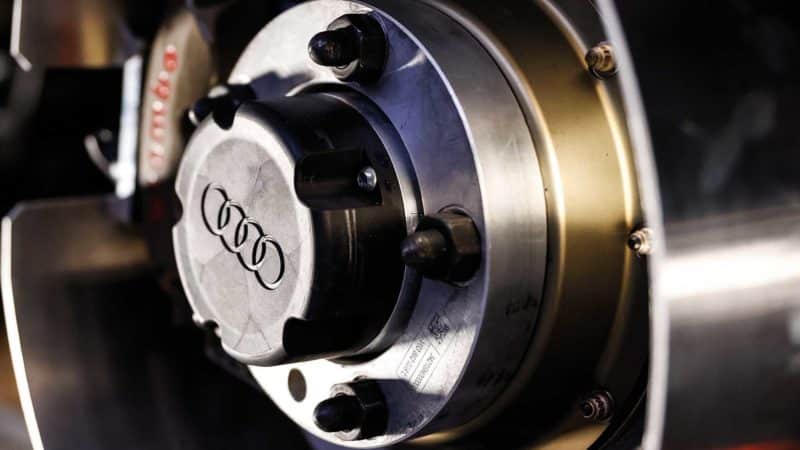
Audi scored 14 podium results on 15 event days.
Audi AG
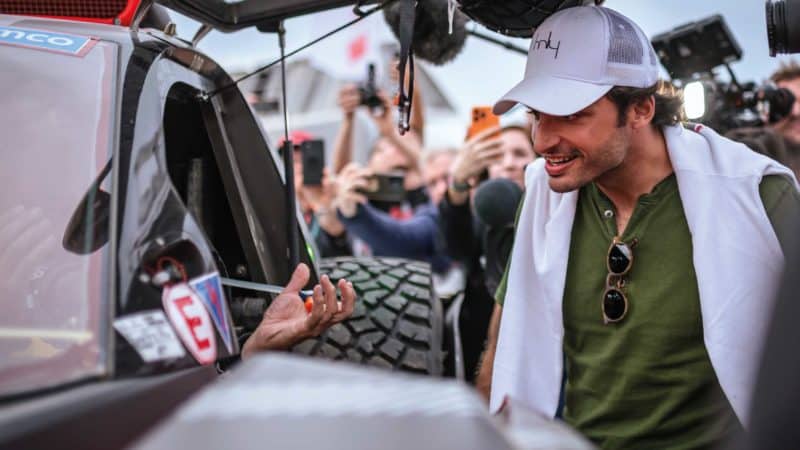
Carlos Sainz Jr supporting Dad.
Red Bull content pool

Dakar Rally’s stage one sea camp.
Audi AG
But even with the best driver and best navigator, it’ll be a miserable race if you don’t get on. Because you’re sitting uncomfortably close to each other for six to eight hours a day for the full 14-stage rally, centred around the fraught subject of navigation, where a wrong turn is more serious than missing the A1 exit to Wittering.
Competitors also bunk up together: due to the rally’s remoteness, crews can forget five-star hotels or luxury motorhomes. Instead, top competitors share campervans and count themselves lucky that they aren’t sleeping in tents, as many other riders, drivers (and all the crew) do.
“We need to trust each other 100%,” says Baumel, who races in Rally-Raid events throughout the year with his co-driver. “If you can do your job with no pressure, no stress, you work much better. We are more than friends. We are from the same family. Last year we spent 220 days together. I spend more time with Nasser than with my wife and the kids. It’s why we stay in the campervan — and why we sometimes go on holiday together.”
It is teamwork, completely on the fly. Where competitors in the original Dakar received paper roadbooks containing details in advance, today’s racers receive them moments before starting the stage.
Solo riders are still given a paper version that they have to rapidly fit to a roller on the handlebars. Those in cars, buggies and trucks receive it on a dashboard screen via Wi-Fi as they line up for the stage start, and then it’s straight into the unknown.
Phones are banned and have to be sealed in a bag before the start of each stage and are checked at the end.
“I really need to focus on the roadbook,” says Baumel. “If I miss one junction or if I don’t follow where the car enters the dunes, I will not find the next point, so I am lost.”
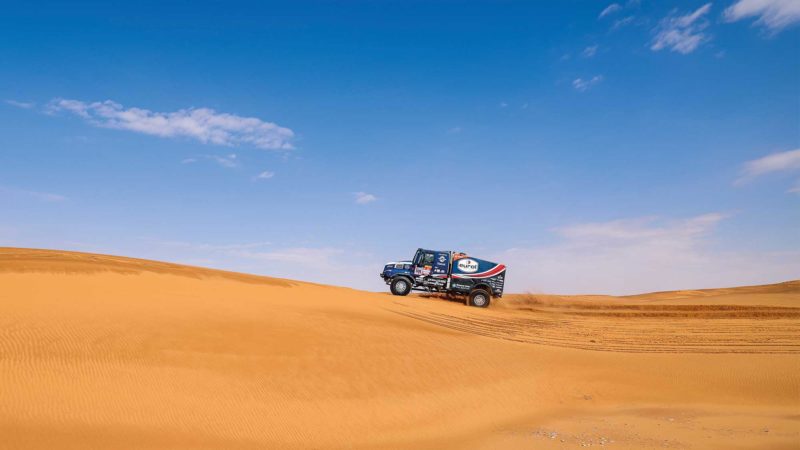
Team de Rooy’s Iveco No506 truck would finish third with an all-Dutch crew.
ASO/C Lopez/J Delfosse/DPPI
As technology has developed, so has the guidance, in an effort to maintain the Dakar’s formidable challenge. “When I started, there was no GPS at all,” says Stéphane Peterhansel, the most successful competitor in the race’s history with 14 victories — six on motorbikes and eight in cars. “[We had] just a compass and it was possible to be lost for one day, one night, three days. My first Dakar I spent one night on the desert.
“The electronic roadbook is really new [since 2021]. The problem was when we got the roadbook before, it was possible to make a route on Google Earth. You can bring it with you in the car and it’s not easy to check. After that it’s not a question of navigation, you just follow the tracking. They wanted to stop this thing.”
The principles remain the same. The aim is to drive by all of the listed waypoints between the start of the stage and the end, following directions that are listed in a long list of boxes known as ‘tulips’.
You’ll typically be shown a line tracing the rough path you should take and a number in a yellow box known as a CAP, which is the compass bearing. These are usually accompanied by one or more of the official symbols, which can depict navigational elements such as water tanks or palm trees; hazards, such as ditches, bumps or dunes; or areas where speed is limited. Also listed is the distance travelled since the start of the rally and the distance you’ll cover before the next direction.
“The game of the organiser is to give us a lot of information to read,” says Peterhansel’s co-driver Edouard Boulanger. “That way you have to transmit this information to the driver, to navigate by yourself, to make like a small gymkhana.”
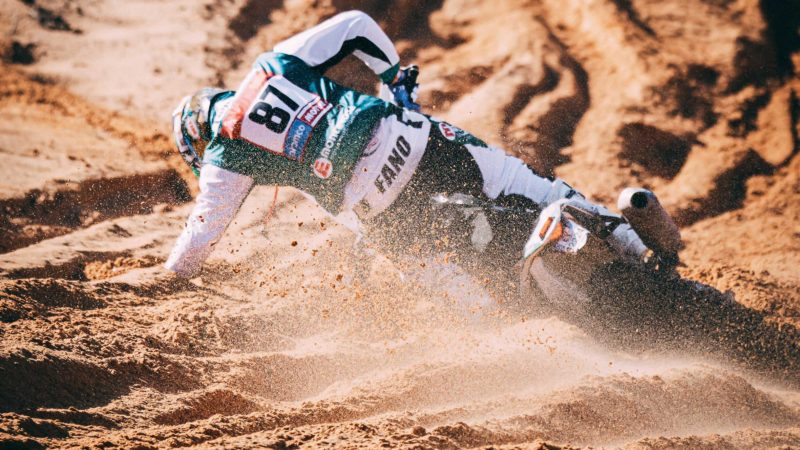
Italian Lorenzo Fanottoli battling to a top-50 finish
ASO/C Lopez/J Delfosse/DPPI
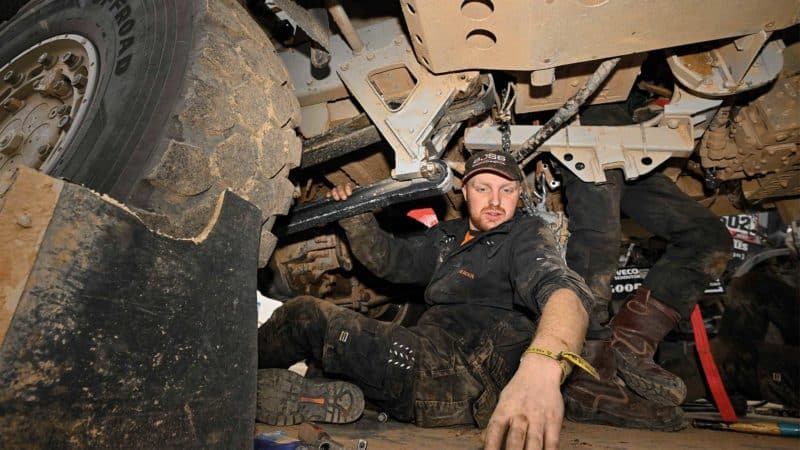
Attention to No506
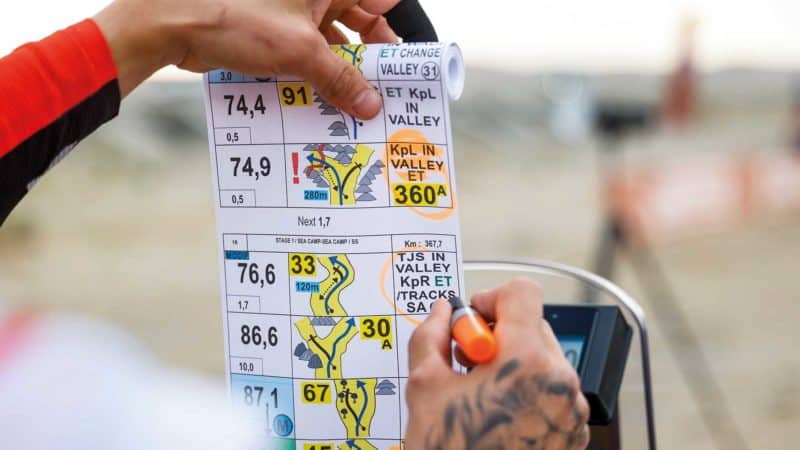
Sam Sunderland highlights route tulips, stage one
Red Bull content pool
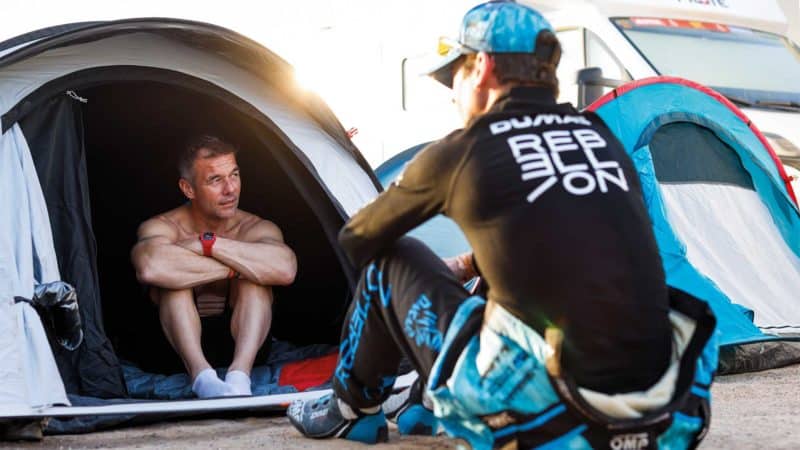
Happy campers Loeb and Dumas
DPPI
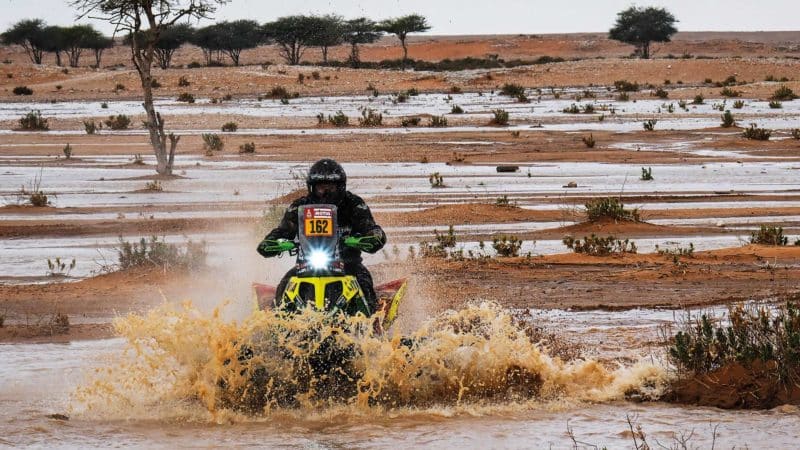
Desert rains
ASO/C Lopez/J Delfosse/DPPI
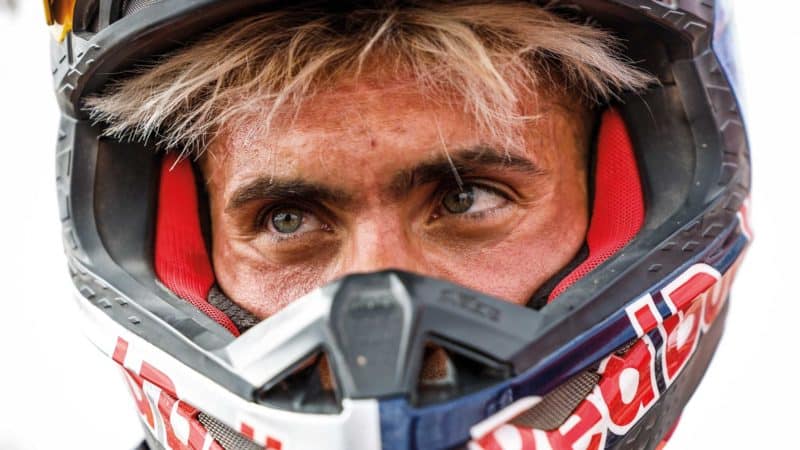
Bike winner Kevin Benavides
Red Bull content pool
The standard in-car digital displays include an arrow showing the direction to the next waypoint, but this only appears once you’re within 800m of the target. Competitors have to get within 30m-90m (it varies depending on the waypoint) to tick it off and move on to the next one. At this point the arrow disappears, and navigators are back to their line drawings. Baumel says that route-setters have their own distinctive styles, so he can tell when part of the roadbook was drawn by one person, and part by another.
“Last year I spent 220 days with Nasser – more time than with my wife and kids”
“They draw one line for one path [to follow], but you can imagine that I [can see] many of them on the ground,” he says. “So I need to follow the CAP. Sometimes it can be 10-15km between waypoints. Today, for a 425km stage, I think we had 102 waypoints.
“Mistakes happen every day. We have to do fewer mistakes than the others: when you make a mistake, the only way is to come back to the last point where you are sure – 100%. Sometimes it’s 500m, sometimes it’s 3-4km.”
In theory, it’s straightforward, but driving close to the route of one stage in a road-going Toyota Land Cruiser, it’s anything but. Camel grass-covered mounds make it impossible to drive in a straight line, while dunes soar around us. Some are simple to climb. In others, your correspondent becomes embarrassingly bogged down. And the other side remains a mystery until you are over the crest: will it be a ditch, thick vegetation or a precipitous drop?
It’s daunting driving in second gear. Trying to navigate this at the Dakar cars’ maximum velocity of some 105mph is unfathomable. Navigating it in the race means adapting your route to what lies ahead. Al-Attiyah, who claimed his fifth win in the car category at this year’s event, with a dominant 45min lead, says the key is looking well into the distance and mapping out the path. But he’s just being modest.
“Nasser will check where the wind will come from, then he already predicts how the dune has been shaped,” says Toyota team leader Alain Dujardin. “He will look to the shadows of the dune so that gives him an idea of the difficulty ahead. The co-driver will define the CAP and Nasser will decide the dune to go over.”
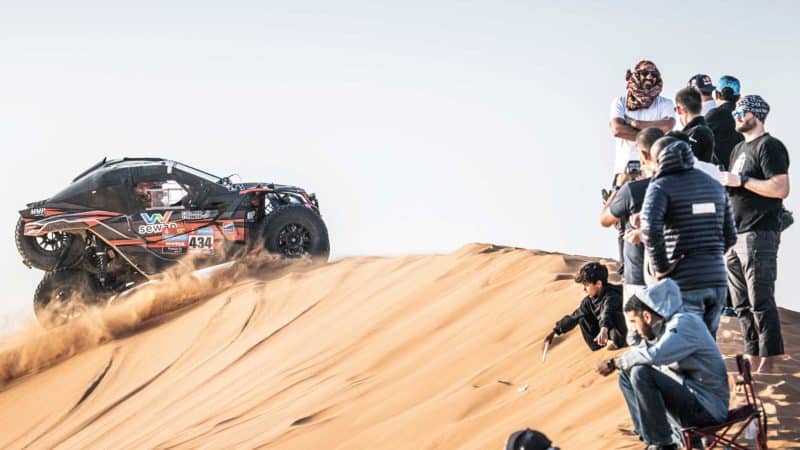
Spectating brought back memories of WRC in the 1980s – and a fan would be killed.
ASO/C Lopez/J Delfosse/DPPI
There’s plenty to put drivers under pressure but the Qatari racer, who used to compete in WRC alongside Baumel, has an advantage shared with Jackie Stewart. Both are accomplished marksmen and credit the sport with their Zen mindset when racing. Al-Attiyah won a bronze medal for skeet shooting at the London 2012 Olympic Games and is looking to improve on that with a gold at Paris 2024.
“It’s helped a lot with focusing, with concentration, how to be calm behind the wheel and always you really have sharp eyes,” he says, outlining how he typically drives slower than he can to look after the car and prevent damage. “I don’t spend a lot of energy inside the car, [so] if I need to push I can have another level. For example, in the last 30km [of stage 4] I took from everybody 3min. I wanted to see in the split where I am, where the level of the car is and when we see the 3min, I said, ‘OK, we can use it.’”
“You need to judge in the moment if you can climb or not”
For Peterhansel, experience racing on a motorbike is invaluable. “The line of the motorcycles helps a lot,” he says. “I was [racing] with the motorcycles so I am able to anticipate a bit before.”
Working out the shortest achievable route doesn’t come without its peril. The following day, Carlos Sainz attempts to scrabble up a dune at full power but his squealing Audi falters and crabs along the steep incline, slipping gradually lower. It’s a compelling 25sec of car against dune, which is eventually won by Sainz.
However, his luck runs out later in the stage. “You need to judge in the moment if you can climb or you cannot,” says the three-time Dakar winner. “Today, close to the end, I lost a bit of time. I tried to climb and had to turn around and choose another way. This is a decision you have to take. I knew it was a risky situation.”
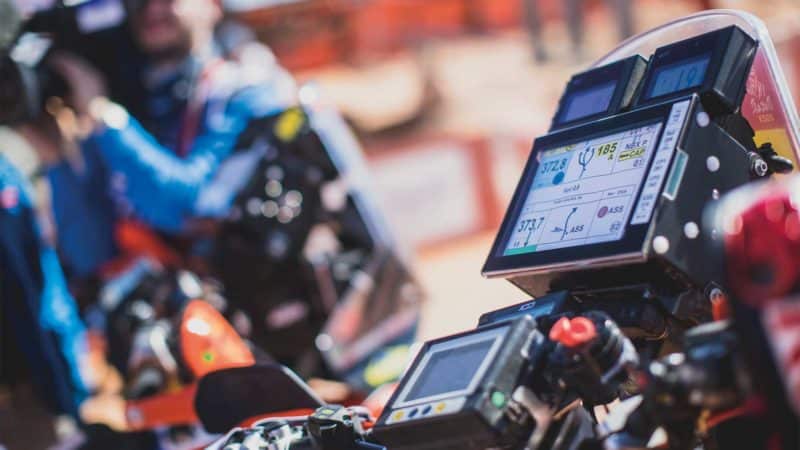
Despite the navigation tech, it is still possible to lose your way.
Red Bull content pool
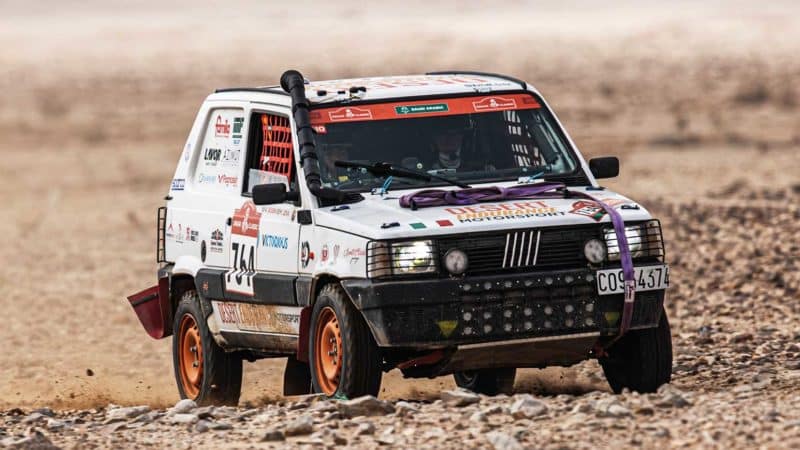
Fiat Panda in the Classic
ASO/C Lopez/J Delfosse/DPPI
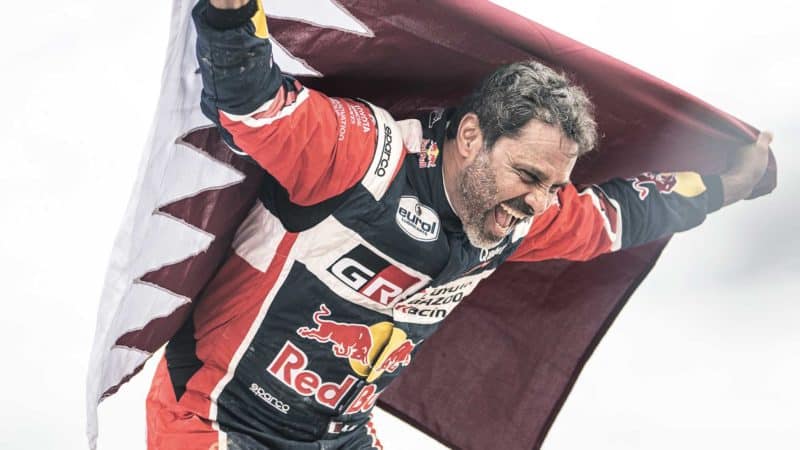
another Dakar win for Nasser Al-Attiyah
ASO/C Lopez/J Delfosse/DPPI
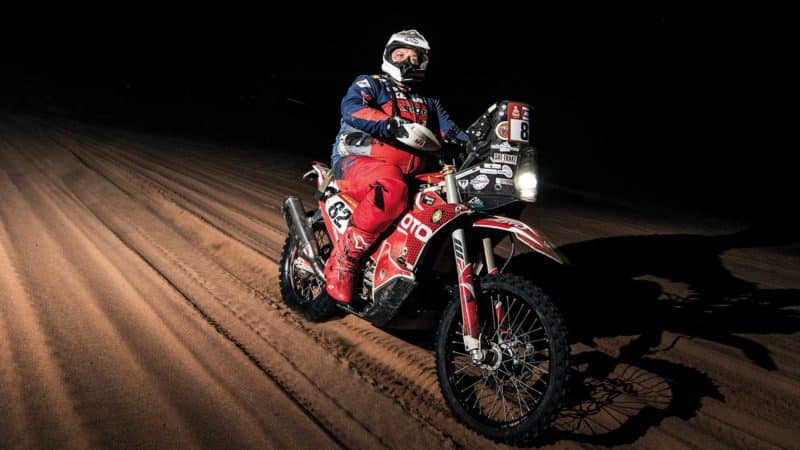
Night doesn’t stop racing
ASO/C Lopez/J Delfosse/DPPI
At the age of 60 and with 16 Dakars under his belt, Sainz has seen more than most, but that’s not why the rally winners are dominated by racing’s elder statesmen, says Peterhansel, 57. “We need experience but this is also a question of spirit,” he says. “With Carlos, we are always fighting, never give up. Some younger drivers take it a little bit more easy. To make the difference, it’s also a lot of the brain, the mental [strength]. Guys like Loeb are multiple WRC champions, Sainz too, Nasser Al Attiyah [aged 52] is also a fighter. Sure we have experience, but we are fighters and never give up. That is key.”
It’s entertainment though, for the few spectators out on the stage (there aren’t enough racing fans in Saudi Arabia, complain drivers — in addition to the human rights concerns). As the bikes make their way up the hillside we’re watching from, we can see more streaming across the desert towards us.
Their path starts as a deceptively narrow track that encourages you to get close to the action – metres away from the bikes. But before long the line suddenly widens as another tranche of riders dodge the churned sand in search of more grip on the climb.
Then come the cars: racing across sand and storming past the later bikes. Skidding, leaping over crests: first comes Loeb, his Prodrive BRX appearing to be a handful, but fast. Then there’s the drone of the Audis in the distance, which seem to glide up the hill, followed by the sand-flinging Toyotas visibly finding the climb harder work.
As the line gets rougher, so it gets wider and wider. Suddenly, a mound we’re standing on at the side of the route is split by two bikes that leap up from a dip below and speed either side of us: we’re literally at the heart of the action, transported back to 1980s rallying, although the exhilaration doesn’t prevent us from retreating.
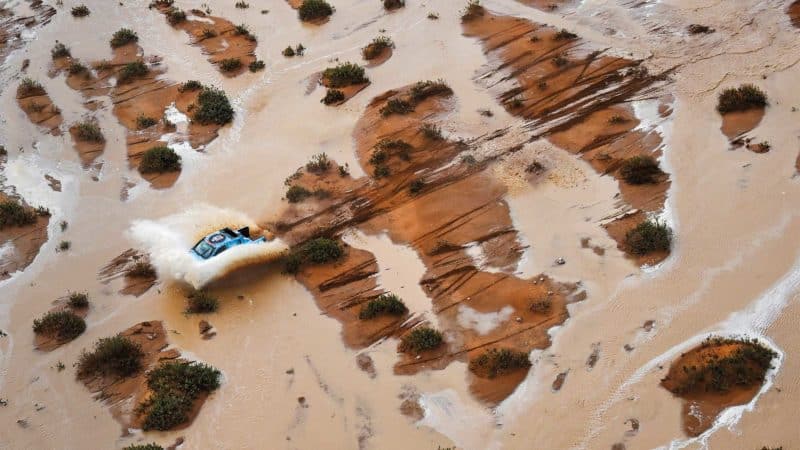
Dumas’s Toyota Hilux in uncharacteristic desert conditions.
ASO/C Lopez/J Delfosse/DPPI
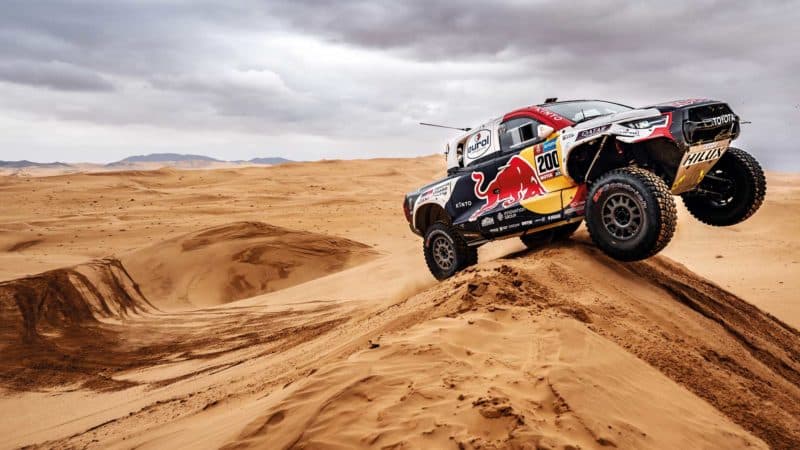
Toyota Gazoo fielded a trio of Hilux T1+s – with this, No200, driven by Al-Attiyah; the Qatari driver went on to take his fifth Dakar title – and a second in succession
It’s evidence of how, on an event where racers go where they like, the risks can suddenly spike. A few days later, a spectator on one side of a dune was killed when the leaders in the truck category came from the other side, blind to the person in their path. The blameless crew weren’t even aware of the incident until the end of the stage, at which point they withdrew from the race.
“We’re literally at the heart of the action, transported back to 1980s rallying”
There was an early end for the two leading Audi crews too, the only serious challengers to Al-Attiyah, who had an 18min lead after stage four. Both Audis hit trouble at the same spot on stage six after soaring over a crest and crashing into a dip. Boulanger suffered broken vertebrae and was airlifted to hospital, and while Sainz and co-driver Lucas Cruz made it to the end, they somersaulted their car over a dune a few days later and the Spaniard was also out with spinal fractures, leaving Al-Attiyah to triumph.
“The Dakar brings you back to exactly the place you should be,” muses Ickx one evening in the temporary paddock. “After 12 editions, I am a different person. I am less bad. You have a different consideration for the human. You see a lot of extraordinary things in the races.
“It’s what I call the third part of my career. And I think it’s the most interesting one because it’s the closest to reality and your human position on this planet.”
Dakar rally Saudia Arabia circuit map
